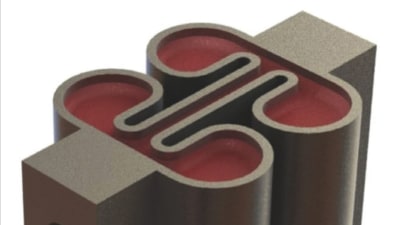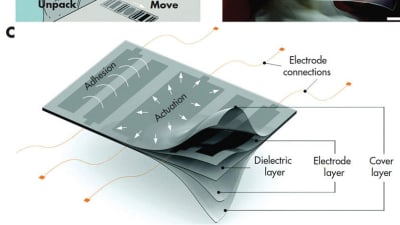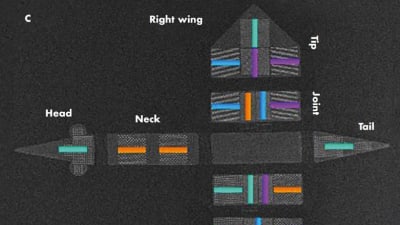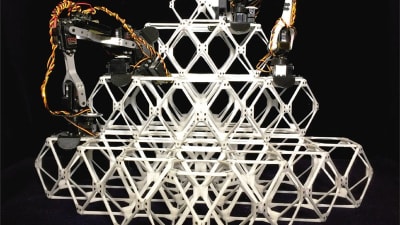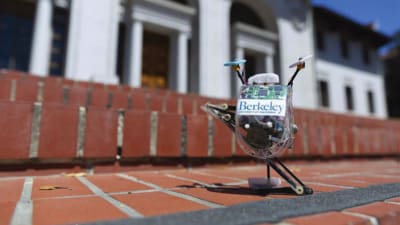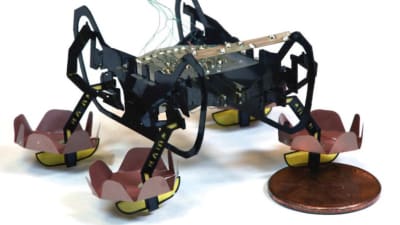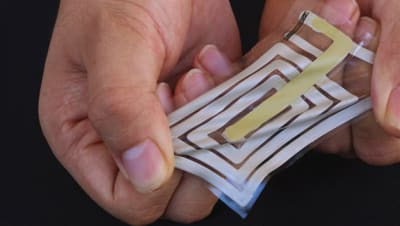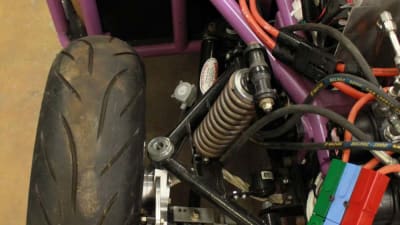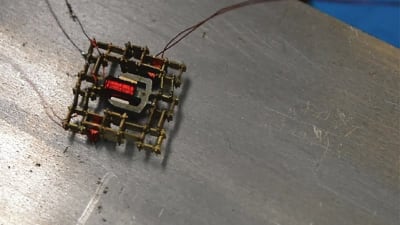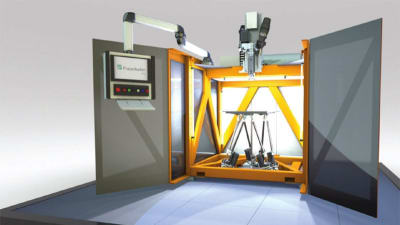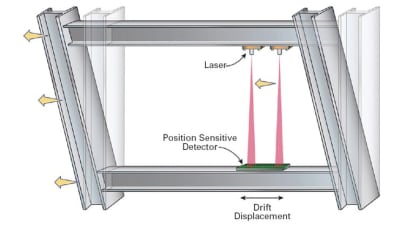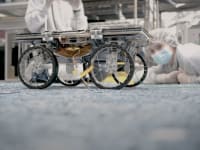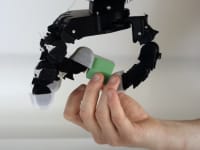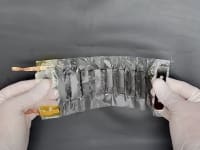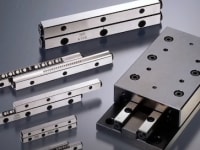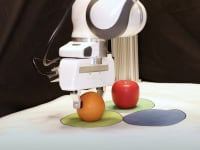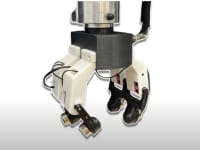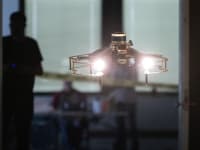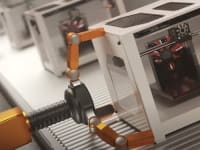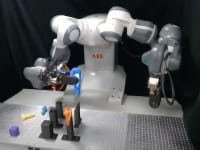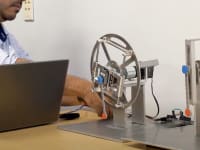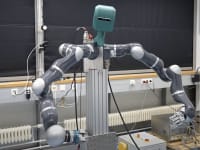40
61
169
-1
180
30
Briefs: Manufacturing & Prototyping
Conventional fastening mechanisms like nails, bolts, and welds are subject to manufacturing and inspection tolerances, differential thermal growth, and other sources of error that lead to over-constraint, among other...
Briefs: Robotics, Automation & Control
These soft robots can be rolled up and carried in a pocket.
Briefs: Electronics & Computers
Such machines, only a few tens of micrometers across, could be used in the human body to perform small operations.
Briefs: Robotics, Automation & Control
Systems of tiny robots could build high-performance structures, from airplanes to space settlements.
Briefs: Robotics, Automation & Control
This robot “blood” stores energy, transmits force, operates appendages, and provides structure, all in an integrated design.
Briefs: Imaging
An upgraded mini robot can leap over obstacles with ease.
Briefs: Mechanical & Fluid Systems
This microbot can walk on land, swim, and walk underwater.
Briefs: Sensors/Data Acquisition
Loosely connected disc-shaped “particles” can push and pull one another, moving together to transport objects.
Briefs: Wearables
These stickers wirelessly beam health readings to a receiver clipped onto clothing.
Briefs: Energy
Power System for Hybrid Heavy-Duty Trucks
Electric motors and gas-alcohol engines could slash pollution levels and greenhouse gases from long-haul trucks.
Briefs: Sensors/Data Acquisition
A technology uses a combination of WiFi signals and accelerometer technology to track devices in near-real-time.
Briefs: Automotive
Researchers have developed a self-contained wheel unit that combines a wheel and an electric motor.
Briefs: Imaging
The technology can be used in commercial motors, robotic systems, and hybrid and electric vehicles.
Briefs: Motion Control
The skin could help rehabilitation and enhance virtual reality by instantaneously adapting to a wearer's movements.
Briefs: Electronics & Computers
A synthetic skin enables robots to sense their own bodies and surroundings
Briefs: Sensors/Data Acquisition
The algorithm speeds up the planning process that robots use to adjust their grip on objects.
Briefs: Sensors/Data Acquisition
Researchers have created a motion-powered, fireproof sensor that can track the movements of firefighters, steelworkers, miners, and others who work in high-risk environments where they cannot always be seen. The...
Briefs: Robotics, Automation & Control
A perception system for soft robots was developed that is inspired by the way humans process information about their own bodies in space and in relation to other objects and people. The system includes a motion...
Briefs: Motion Control
Wearable Motion Sensors Measure Fetal Heartbeat
A technique was developed that could allow expectant parents to hear their baby’s heartbeat continuously at home with a non-invasive and safe device that is potentially more accurate than any fetal heartrate monitor currently available in the market.
Briefs: Aerospace
Neural Lander Uses AI to Land Drones Smoothly
Landing multi-rotor drones smoothly is difficult. Complex turbulence is created by the airflow from each rotor bouncing off the ground during a descent. This turbulence is not well understood nor is it easy to compensate for, particularly for autonomous drones. That is why takeoff and landing are often...
Briefs: Manufacturing & Prototyping
A smartphone app was developed that allows a user to easily program any robot to perform a mundane activity such as picking up parts from one area and delivering them to another. The app, called VRa, uses...
Briefs: Robotics, Automation & Control
Soft robots have a distinct advantage over rigid robots: they can adapt to complex environments, handle fragile objects, and interact safely with humans. Made from silicone, rubber, or other stretchable polymers, they...
Briefs: Semiconductors & ICs
A set of five tiny fundamental parts can be assembled into a wide variety of functional devices including a tiny “walking” motor that can move back and forth across a surface or...
Briefs: Materials
3D printers that build small parts layer by layer from melted plastic can take up to an hour to produce a pocket-sized piece. This process is far too slow for the mass-production of components...
Briefs: Transportation
A high-sensitivity and low-noise MEMS accelerometer was developed using multi-layer metal structures composed of multiple metal layers. The accelerometer achieves 1 μG level resolution that has...
Briefs: Nanotechnology
An automated system designs and 3D-prints complex robotic parts that are optimized according to an enormous number of specifications. The system fabricates actuators — devices that mechanically control...
Briefs: Software
Antenna Near-Field Probe Station Scanner
Antenna characterization techniques are often expensive and time-consuming. NASA’s Glenn Research Center developed a highly versatile and automated system to perform characterization of single or multiple small circuit antennas, printed on-wafer or on other substrates, by measuring the antenna’s...
Briefs: Robotics, Automation & Control
The Advanced Explosive Ordnance Disposal Robotic System (AEODRS) features a modular open systems architecture that enables the robot to be self-righting after a fall. The self-righting...
Briefs: Data Acquisition
Berkeley Lab technology could reduce time needed to declare buildings affected by earthquakes safe and sound.
Top Stories
Blog: Manufacturing & Prototyping
2025 Holiday Gift Guide for Engineers: Tech, Tools, and Gadgets
INSIDER: Energy
Scientists Create Superconducting Semiconductor Material
Blog: Software
Blog: Materials
This Paint Can Cool Buildings Without Energy Input
Quiz: Automotive
Blog: Semiconductors & ICs
Webcasts
 Upcoming Webinars: Manufacturing & Prototyping
Upcoming Webinars: Manufacturing & Prototyping
The Real Impact of AR and AI in the Industrial Equipment Industry
 Upcoming Webinars: Motion Control
Upcoming Webinars: Motion Control
Next-Generation Linear and Rotary Stages: When Ultra Precision...
 Upcoming Webinars: Transportation
Upcoming Webinars: Transportation
Hydrogen Engines Are Heating Up for Heavy Duty
 Podcasts: Medical
Podcasts: Medical
How Wearables Are Enhancing Smart Drug Delivery
 Podcasts: Automotive
Podcasts: Automotive
SAE Automotive Podcast: Solid-State Batteries


